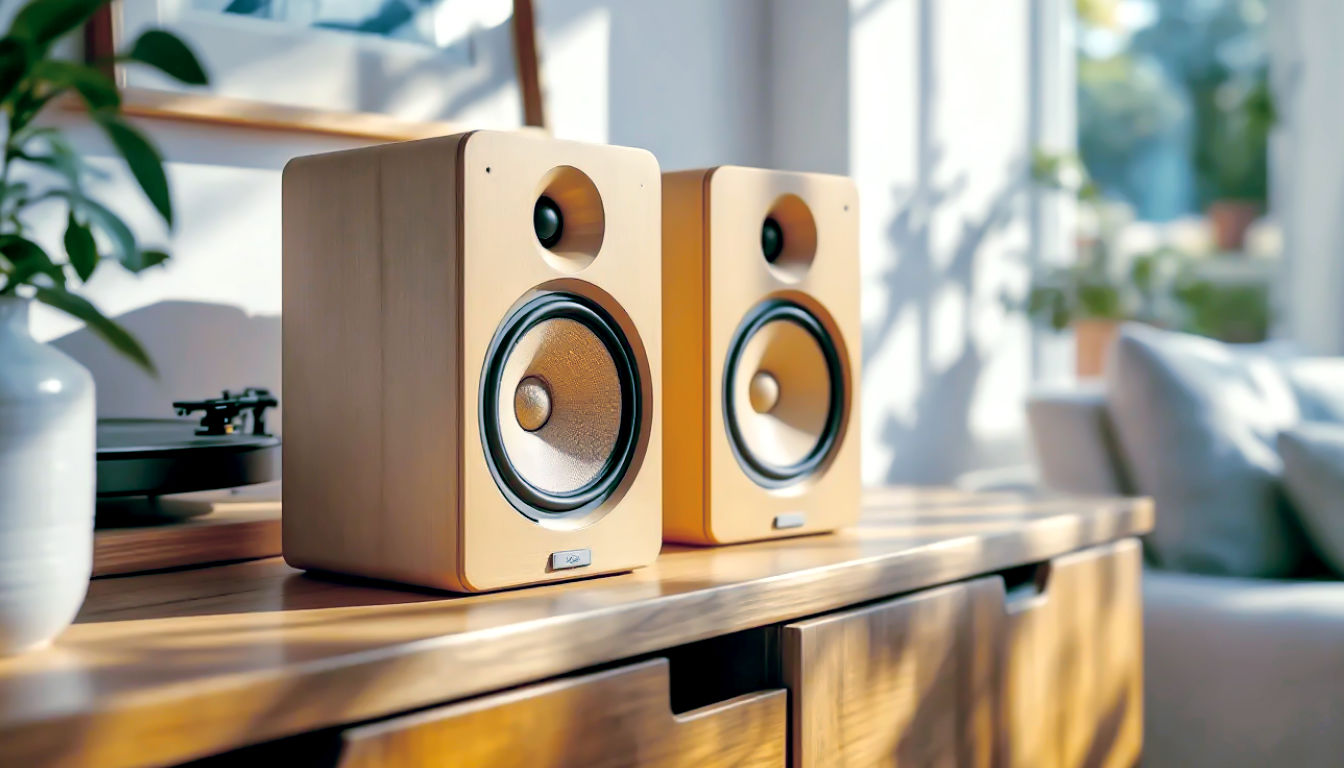Sound That Doesn’t Cost the Earth: The Guide to Sustainable Audio Systems
sustainable audio systems, what is ethical sound, eco-friendly hi-fi UK, repairable headphones uk, sustainable speaker materials, best ethical audio brands, how to buy sustainable audio, environmental impact of audio equipment, circular economy in electronics, choosing sustainable speakers, right to repair movement uk

This post may contain affiliate links. If you make a purchase through these links, we may earn a commission at no additional cost to you.
Let’s be honest, most of us love music. We love how it can fill a room, start a party, or just help us unwind after a long day. We spend a good chunk of our cash on speakers, headphones, and turntables to get the best possible sound. But have you ever stopped to think about what your audio gear is made of, where it comes from, or what happens to it when it’s no longer wanted?
The truth is, the world of audio equipment hasn’t always been kind to the planet. From rare metals mined in difficult conditions to plastics that take centuries to break down, our love for sound has a hidden environmental cost. But things are starting to change. A new movement is growing, one focused on sustainable audio—creating sound systems that are not only brilliant to listen to but also built with respect for the people and the planet that make them possible.
This isn’t about sacrificing quality for eco-friendliness. Far from it. This is about smart design, innovative materials, and a return to the idea of buying something truly special that’s built to last a lifetime. It’s about sound you can feel good about. So, whether you’re a die-hard audiophile with a collection of vintage valve amps or just someone who enjoys a good kitchen disco, this guide will walk you through everything you need to know about the world of ethical sound. We’ll explore what it means, who’s doing it right here in the UK, and how you can make choices that are better for your ears and the Earth.
What on Earth is Sustainable Audio Anyway?
Before we dive in, let’s get our terms straight. What do we actually mean by ‘sustainable’ or ‘ethical’ when we talk about a pair of speakers or headphones? It’s not just about slapping a ‘recyclable’ sticker on the box. It’s a much bigger, more interesting picture that covers the entire life of a product, from the drawing board to the day it’s eventually retired (hopefully many, many years from now).
Think of it like a three-legged stool: to be truly sustainable, an audio product needs to balance on Planet, People, and Performance.
Planet: The Environmental Footprint
This is the bit most people think of first. It’s all about the impact a product has on the natural world. It covers:
- Materials: Where do the raw materials come from? Are the woods from responsibly managed forests (look for an FSC or PEFC certification)? Are the plastics recycled? Are manufacturers avoiding toxic glues and finishes? Some innovative British companies are even using things like recycled paper, cork, or even a special type of concrete that’s less damaging to produce.
- Manufacturing: How much energy and water does it take to build the product? Is the factory powered by renewable energy? Do they minimise waste, perhaps by reusing offcuts of wood or metal?
- Energy Consumption: How much electricity does the device use when you’re listening to it? And just as importantly, how much does it use on standby? Modern amplifiers, for instance, are far more efficient than the power-hungry behemoths of the 1980s.
- End-of-Life: What happens when it breaks or you want to upgrade? Can it be easily repaired? Are the parts recyclable? A truly sustainable product is designed to be taken apart and reused, not just chucked in a landfill. This is a huge problem in the tech world, often called ‘e-waste’.
People: The Human Cost
This is the ethical side of the coin. It’s about ensuring that everyone involved in making your audio gear is treated fairly and with respect.
- Supply Chains: This means checking that the raw materials, like cobalt for batteries or tin for soldering, aren’t mined in conflict zones or by people, including children, working in dangerous conditions. It’s a tricky area to get right, but the best companies are open about where their stuff comes from.
- Working Conditions: Are the people in the factory paid a living wage? Do they have safe working conditions and fair hours? Many great British audio brands pride themselves on manufacturing right here in the UK, where we have strong labour laws. This not only supports local jobs in places like Cambridge, Yorkshire, and Glasgow but also gives them direct control over quality and ethics.
Performance: Built to Last, Not to Replace
This is where sustainability meets high-fidelity sound. In the world of audio, performance isn’t just about how loud it goes or how deep the bass is. It’s about longevity.
- Durability and Repairability: A truly sustainable product is built to last for decades, not just a couple of years. Think of those classic turntables from the 70s that are still going strong. The ability to repair and upgrade equipment is key. Can you replace a broken part easily, or is the whole thing glued shut? Companies that offer repair services or sell spare parts are a big green flag.
- Timeless Design: It’s also about avoiding fleeting trends. That hot pink Bluetooth speaker might look cool today, but will you still love it in five years? Classic, simple design made from quality materials doesn’t go out of style. It’s the difference between fast fashion and a beautifully made coat you’ll wear for life.
Putting it all together, a sustainable audio system is one that sounds amazing, is made with care from responsible materials by people who are treated well, uses minimal energy, and is designed to be a companion for life, not just for Christmas.
The Journey of Sound: How We Got Here
To understand why sustainable audio is so important now, it helps to look back at how the industry developed. It’s a story of incredible innovation, but also one of mass production and a throwaway culture that we’re only just starting to unpick.
The Golden Age: Craftsmanship and Pride
If you look at the early days of hi-fi in the post-war era, particularly in Britain, things were very different. Companies like Leak, Quad, and Wharfedale (still going strong in Yorkshire!) were born out of a passion for engineering and music. Their products weren’t just electronics; they were pieces of furniture, often beautifully crafted from wood and metal in local workshops.
- Built by Hand: These early systems were often assembled by hand by skilled technicians. They were designed to be the centrepiece of a living room, a source of family pride.
- Repair Was Normal: If something went wrong, you didn’t throw it away. You took it to a local repair shop or even fixed it yourself. The designs were modular, meaning you could swap out a faulty valve or capacitor. They were built to be serviced, not sealed shut. This was the original circular economy, long before we had a fancy name for it.
The Rise of Mass Production and Plastic
From the 1970s onwards, things began to change. The arrival of affordable electronics from the Far East, the invention of the cassette tape, and later the CD, brought music to the masses like never before. This was fantastic in many ways, but it came at a price.
- The Shift to Plastic: Wood and metal gave way to cheaper, lighter plastic. This made products more affordable, but it also meant they felt less special and were much harder to recycle.
- Designed for the Bin: To keep costs down, manufacturing became highly automated and moved overseas. More importantly, products were increasingly designed with a limited lifespan in mind. It became cheaper to buy a new CD player than to fix your old one. This is known as planned obsolescence, and it’s a core problem that the sustainable movement is trying to fix.
- The Environmental Cost: This boom created a mountain of e-waste. Old stereos, Walkmans, and portable speakers contain a cocktail of materials—plastics, heavy metals like lead and mercury, and flame retardants—that can be harmful if they end up in landfill.
The Digital Age: Convenience vs. Consequence
The arrival of MP3s, streaming, and Bluetooth speakers in the 2000s changed the game again. Music became invisible, portable, and instant. We swapped our cherished record collections for a subscription to Spotify.
- The Proliferation of Gadgets: Suddenly, everyone needed headphones for their commute, a Bluetooth speaker for the park, and a smart speaker for the kitchen. These devices are often small, cheap, and not designed to be repaired. How many pairs of broken earbuds have you thrown away in your life?
- The Hidden Energy Drain: While a small smart speaker doesn’t use much power on its own, think about the vast, energy-guzzling data centres that power Spotify and Apple Music. Streaming music 24/7 has its own environmental footprint that we rarely see.
This isn’t to say that modern technology is all bad. Far from it. But this journey shows how we’ve moved from a culture of craftsmanship and care to one of convenience and consumption. The sustainable audio movement is about finding a way to bring back the best of the old ways—the quality, the longevity, the pride of ownership—and combine it with the best of the new.
The Anatomy of a Sustainable Speaker: What to Look For
So, you’re in the market for some new audio gear and you want to make a good choice. What should you actually be looking for? Let’s break down a typical audio product, like a speaker, and see where sustainability comes in.
The Cabinet: More Than Just a Box
The box that houses the speaker drivers is called the cabinet. It plays a huge role in the sound, and it’s also where material choice is most obvious.
- Sustainable Wood: The classic material for a speaker cabinet is wood, usually MDF (Medium-Density Fibreboard). Look for companies that use FSC-certified wood, which guarantees it comes from a forest managed in a way that protects biodiversity and the local community. Some high-end British brands, like Fyne Audio from Scotland, are known for their beautiful, handcrafted wooden cabinets.
- Bamboo: A fast-growing grass, bamboo is a fantastic sustainable alternative. It’s strong, light, and grows to maturity in just a few years, compared to decades for hardwood trees.
- Recycled Materials: This is where things get really creative. Some companies are making cabinets from recycled wood pulp, recycled plastics, or even reclaimed wood from old buildings.
- Cork: Natural, renewable, and a brilliant sound-dampener, cork is another wonder material being used by eco-conscious brands.
- Bad Materials: Avoid speakers made from virgin plastics where possible. Also, be wary of exotic hardwood veneers that might not be sustainably sourced.
The Guts: Electronics and Drivers
Inside the cabinet are the drivers (the cone-shaped bits that make the sound) and the crossover (the electronic circuit that directs the right frequencies to the right driver).
- Driver Materials: The cones can be made from paper, plastics, or metals like aluminium. Look for companies using recycled paper or recycled aluminium. The magnets that power the drivers often use rare-earth elements like neodymium. This is a tricky area, as mining these metals can be environmentally damaging. The most sustainable companies are working on designs that use less of these materials or are exploring ways to recycle them.
- Lead-Free Solder: A small but important detail. Solder is the glue that holds electronic circuits together. Traditionally, it contained lead, which is toxic. Look for the RoHS (Restriction of Hazardous Substances) compliance mark, which means the product is free from lead and other nasty chemicals.
- Efficient Design: Good electronic design means the speaker uses power efficiently, turning more electricity into sound and less into wasted heat.
Case Study in British Innovation: KEF and Metamaterials
Kent-based loudspeaker manufacturer KEF is a brilliant example of performance-led sustainability. While known for their high-end sound, they’ve also focused on longevity and material science. Their recent speakers use something called Metamaterial Absorption Technology (MAT).
- Simplified Explanation: Imagine shouting into a cave. The echo you hear is unwanted sound bouncing back. Inside a speaker, the driver also creates sound that goes backwards, into the cabinet. This can bounce around and mess up the sound coming out of the front. MAT is like lining the cave with a super-complex maze that traps 99% of that unwanted sound.
- Detailed Explanation: MAT is a synthetic material with a highly complex, labyrinth-like structure. Each channel in the structure is engineered to absorb a specific frequency. Together, they act as an “acoustic black hole,” preventing sound from reflecting back through the driver cone. This results in a much purer, cleaner sound. By innovating in performance, KEF creates speakers that people won’t want to replace, which is a core principle of sustainability. They are designed for a lifetime of listening.
Repairability: The Anti-Obsolescence Factor
This is perhaps the most important factor of all. Can the product be fixed?
- Modular Design: This means the product is designed in separate, replaceable blocks. If the amplifier part of your active speaker fails, can you just swap that module out, or do you have to bin the whole thing? Vifa, a Danish brand, makes beautiful modular speakers you can link together or upgrade over time.
- Availability of Spares: Does the company sell spare parts like drivers, cables, or even new foam pads for headphones? Brands like Sennheiser and Beyerdynamic are great at this, allowing you to keep your favourite headphones going for years just by replacing worn-out parts.
- Standard Screws and Connectors: It sounds simple, but using standard screws instead of weird, proprietary ones (we’re looking at you, Apple) makes a huge difference. It means you or a local repair shop can actually open the device without specialist tools.
A fantastic UK-based example is Rega. Based in Essex, they’ve been making turntables and amplifiers since the 1970s. Their philosophy has always been to build sensible, high-performance products that last. You can still get parts for most of the turntables they’ve ever made, and their designs are famously easy to service and upgrade. Buying a Rega turntable isn’t just buying a product; it’s buying into a system you can maintain for life.
Beyond the Speaker: The Rest of the System
Of course, your sound system is more than just speakers. Let’s look at the other components.
Amplifiers: The Power Behind the Music
The amplifier gives the music signal the oomph it needs to power your speakers.
- Energy Efficiency: Modern amplifiers, particularly Class D designs, are incredibly efficient. They run cool and use a fraction of the power of older designs, both when playing music and on standby. British brands like Cambridge Audio and Naim have invested heavily in creating powerful amps that don’t cost a fortune to run.
- Build Quality: Just like with speakers, look for solid metal casework instead of flimsy plastic. A well-built amplifier from a reputable brand can last for 30 years or more.
Headphones: The Personal Listening Challenge
Headphones are a huge sustainability headache. They are often treated as disposable fashion items. But there are better options.
- Wired vs. Wireless: Wired headphones are generally more sustainable. They don’t have batteries, which have a limited lifespan and are difficult to recycle. A good pair of wired headphones can last indefinitely. Wireless headphones are convenient, but the tiny lithium-ion batteries inside will eventually die, and they are often impossible to replace, rendering the whole product useless.
- Repairability is King: Look for headphones where you can easily replace the cable, the earpads, and even the headband. AIAIAI Audio makes fully modular headphones where every single part can be replaced or upgraded, so you can adapt them to your needs over time.
- Materials: Look for headphones that use wood, metal, and durable fabrics instead of just plastic. Grado, a family-run company from the US, makes fantastic-sounding headphones from wood, and they are fully serviceable.
The Fairphone of Audio: Fairphone’s Fairbuds
A great example of a company tackling this head-on is Fairphone. Known for their ethical, repairable smartphones, they’ve now brought that philosophy to audio with their Fairbuds. They are designed so that you can easily replace the batteries in both the earbuds and the charging case yourself. This is a game-changer. It turns a product that might have been useless in two years into something you can keep for much, much longer. It proves that even small, complex electronics can be designed with sustainability in mind.
Cables and Accessories: The Finishing Touches
Even the cables connecting your system can be made more sustainable. Look for companies that use recycled metals and plastics and offer a lifetime warranty. Good quality cables will also last longer, preventing the need for replacements.
How You Can Be a More Sustainable Music Lover: Practical Tips
It’s not just up to the manufacturers. We, as consumers, have a huge amount of power. The choices we make can drive the industry in a better direction. Here’s how you can make a difference.
1. Buy Second-Hand: The Greenest Choice of All
The most sustainable product is the one that already exists. The second-hand audio market is a treasure trove of incredible gear at brilliant prices.
- Where to Look: Websites like eBay and Gumtree are obvious choices, but also check out specialist hi-fi forums and local dealers who sell used equipment. You’ll find classic amps, turntables, and speakers from legendary British brands that were built like tanks and still sound amazing today.
- What to Look For: Do a bit of research on classic models known for their reliability. A 1990s amplifier from Arcam or Creek can often outperform a brand-new budget amp and will probably outlast it too.
- The Benefits: You’ll save a huge amount of money, get a better-quality product, and completely sidestep the environmental impact of manufacturing something new. It’s a win-win-win.
2. Prioritise Repair Over Replacement
Your amplifier is making a funny crackling sound. Your first instinct might be to look for a new one. Stop!
- Find a Local Hero: There are still skilled electronics repair technicians all over the UK. A quick search online for “hi-fi repair near me” will likely reveal a local expert who can bring your beloved gear back to life for a fraction of the cost of a replacement.
- DIY: If you’re feeling brave, websites like iFixit have free guides on how to repair thousands of electronic devices. Fixing something yourself is incredibly rewarding.
- Support Repair-Friendly Brands: When you do buy new, choose brands that actively support repair by making guides and spare parts available.
3. Ask the Right Questions When Buying New
If you are buying new, do your homework. Don’t just look at the price and the specs.
- Check Their Website: Does the company talk about sustainability? Are they transparent about where their materials come from and who makes their products? Do they have any certifications like B Corp, which is a rigorous assessment of a company’s social and environmental performance?
- Look at the Materials: Is it made from wood, metal, and other durable materials, or is it all plastic?
- Ask About Warranty and Repairs: Do they offer a long warranty? Do they have a repair service in the UK?
- Read Reviews: Look for reviews that talk about build quality and longevity, not just the sound.
4. Think About the Whole System
Your choices go beyond the hardware.
- Download Your Favourites: While streaming is convenient, it uses continuous energy. For the albums you listen to all the time, consider buying and downloading them. Playing a file from your own device uses far less energy than streaming it from a server thousands of miles away.
- Turn It Off: When you’re not using your system, turn it off at the wall. Standby power can account for up to 10% of a household’s electricity bill.
The Future of Sound: What’s Next?
The world of sustainable audio is just getting started, and it’s incredibly exciting. We’re seeing a new wave of designers, engineers, and thinkers who are putting sustainability at the very heart of what they do.
- New Materials: Scientists are developing amazing new materials, from biodegradable plastics made from algae to speaker cones woven from natural fibres like flax and hemp.
- The Circular Economy: The future is circular. This means moving away from the “take-make-waste” model to one where products are designed from the start to be reused, repaired, and recycled. We might see more companies offering “audio as a service,” where you lease the equipment and the company is responsible for maintaining and upgrading it.
- Right to Repair: There’s a growing political movement, the “Right to Repair,” which is pushing for laws that would force manufacturers to make their products easier to fix. This is gaining traction in the UK and Europe and could have a massive impact on the electronics industry.
- A Return to Valuing Our Possessions: Perhaps the biggest change is a cultural one. After decades of cheap, disposable tech, people are starting to want things that last. We’re rediscovering the joy of owning well-made objects that have a story and that we can pass down to the next generation.
Our audio systems are more than just gadgets. They are the conduits for the art form that moves us, inspires us, and brings us together. Choosing a sustainable system is about honouring that connection. It’s about investing in quality, craftsmanship, and a future where the music we love doesn’t have to leave a scar on the world we live in. It’s about ensuring the soundtrack to our lives is one of harmony, in every sense of the word.
Further Reading & Resources
For those looking to dive deeper, these resources are highly respected in the audio and sustainability communities:
- What Hi-Fi?: A leading UK-based publication for audio reviews and news, often covering the build quality and longevity of products. https://www.whathifi.com
- The Repair Association: A leading voice in the Right to Repair movement, advocating for repairable products. https://www.repair.org
- Forest Stewardship Council (FSC UK): The home of sustainable forestry. Check here for information on certified wood products. https://uk.fsc.org
- B Corporation UK: Discover British companies that meet the highest standards of social and environmental performance. https://bcorporation.uk
- iFixit: A global community of people helping each other repair things. A fantastic resource for repair guides and tools. https://www.ifixit.com






